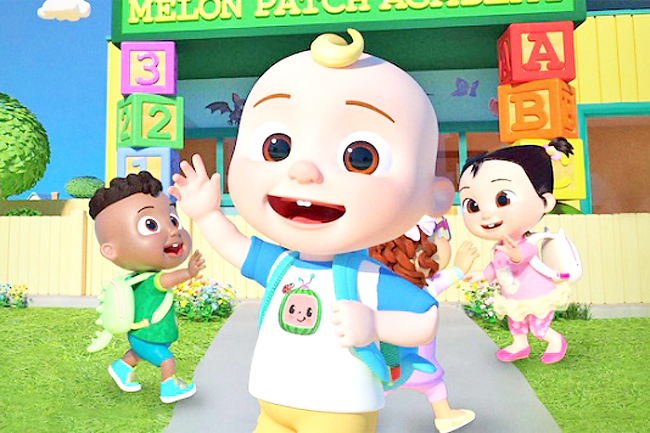Mary Beth Gahan
THE WASHINGTON POST – It was 2018. I had a husband who was deployed half the time, a toddler and a newborn. I grasped at anything that would get me from 6am to naptime, then through the impossibly long afternoon hours that followed in our duplex.
I often needed 20 minutes to feed the baby, or to use my remaining brain power to craft a semi-intelligent work email, or to simply stare into the void. So when my daughter stumbled upon an obscure show with weirdly slow songs that held her attention, I accepted it, and CoComelon became a part of our lives.
It wasn’t until another mom mentioned her fervent wish to never hear Johny Johny Yes Papa again that I realised we were a part of something much larger.
According to recently released figures from Nielsen, CoComelon is an extraordinary streaming success. The second most-streamed show among acquired titles in 2021 (Criminal Minds was first), CoComelon took the top slot in Hispanic, Asian and Black households, easily besting other children’s titles, such as Peppa Pig. And while Criminal Minds had more than 300 episodes available to stream, CoComelon had a mere 15, indicating a staggering number of repeat watches, which added up to 33.3 billion minutes of viewing.
“In its core audience of 2-5 the average viewer watched each episode nearly three times in the fourth quarter alone,” according to Nielsen, information that will shock no parent of a three-year-old.

The explosive appeal of CoComelon is not obvious. The animated series, which began on YouTube and can now be streamed on various services, features a baby, JJ, and his family singing songs such as Wheels on the Bus and The Boo Boo Song. The characters scoop sand on the beach, eat lunch at school and throw away trash in the correct receptacles, all in a trancelike state, as if underwater. Unlike other popular shows geared toward young children, it lacks a plot, character development and spoken dialogue.
But for those who study children’s media, its hit status doesn’t come as a surprise. Senior lecturer in Tufts University’s Child Study and Human Development Department Julie Dobrow likened CoComelon to The Wiggles, a wildly popular show about 20 years ago.
There isn’t a precise formula for what makes something a smash hit among children, Dobrow said, but CoComelon “actually follows a long tradition in children’s media of having songs and highly colourful characters that are dancing”.
“You have to have really good production value, because kids notice, and adults notice, too,” Dobrow said. “Optimally, you have something that works on two levels simultaneously. So children like it, and it’s not too painful for adults to watch.”
“Everything grew organically week by week. There wasn’t a moment of: ‘Aha! This is working.’ Over time, it’s grown,” said Patrick Reese, who has been with the show since 2018 and is CoComelon’s general manager. “There have been a lot of moments of, ‘Wow, this is bigger than we ever thought it would be’.“
To develop new episodes, writers take experiences they have had with their own children or other family members and try to turn “humdrum activities into positive growth opportunities”, said Lead Creative Executive for CoComelon Lizzy Easterday.
In one episode, JJ and his brother take a bath with too many bubbles. They wash their arms, hands, knees and toes to the tune of Baby Shark:
“Wash my hair, doo-doo-doo-doo-doo-doo. Wash my hair, doo-doo-doo-doo-doo-doo. Wash my hair, doo-doo-doo-doo-doo-doo.”
“It has slow-tempo songs that are really distinct to the brand,” she said. “The camera is at the eye level of the pre-schooler. We are in the experience with them and seeing it at their level.”
In this imaginary world inspired by real events, there are no sharp angles – a parent’s dream.
Even the lettering of the subtitles is rounded. The words on the screen help encourage parents and caregivers to sit down and sing the songs with their children, although, after the 10th time of hearing, “Clean up, clean up, we all had fun today,” adults no longer need subtitles to finish out loud: “Now it’s time to clean up and put everything away.”
Despite the fact that parents are probably still singing those songs as they try to fall asleep, that interaction is important, Dobrow said.
“There’s a lot of really compelling research about joint media engagement when children are consuming media alongside somebody else,” she said. “There are a lot of really positive outcomes that can happen, and the learning seems to stick better.”
The show’s repetitive nature and the propensity for children to want to replay episodes add to CoComelon’s appeal. In the same way that children ask to hear a certain book night after night, seeing the show more than once stimulates their brains. It’s not like when Mom and Dad turn on an episode of Seinfeld that they’ve seen 12 times.
“Practice makes permanent,” said associate professor in Tufts’ Child Study and Human Development Department Calvin Gidney. “That repetition teaches them early literacy skills. It helps them learn new words, and it helps them internalise what a story structure is. There’s an educational element to wanting to watch them over and over again.”
As for plot, there isn’t one. There’s no season or series premiere. It started with a family doing routine things around the house; later, other characters were added.
How to explain the success of CoComelon, with its peculiar aesthetics, repetitive songs and lack of story, with the success of something as different as Moana, the second most-streamed movie of 2021?
“What makes good children’s television is it works for different aged kids. It’s early childhood versus pre-school versus tweens,” Gidney said. “Moana had a wide appeal among different ages of children.”
“And when you have Lin-Manuel Miranda doing the music,” Dobrow added, “that helps, too.”






